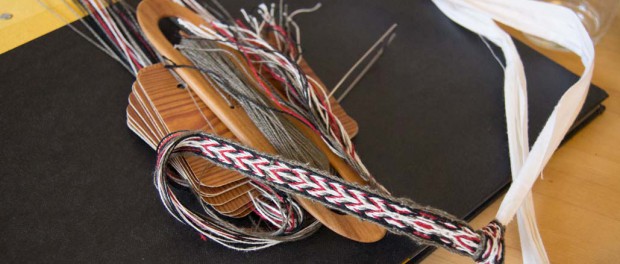Tablet weaving course in Uppsala

Last weekend I visited a tablet weaving course in Uppsala, Sweden. I have wanted to learn this technique for a long time but never took the time to struggle through the instructions I had lying around. I thought it would be more efficient and fun to visit a course with an experienced teacher and that was absolutely right. When I saw that there was a course in Uppsala during the same time I had planned a trip to Sweden I signed up immediately. I was extra happy to see that the course was held by Louise from Spångmurs, one of the most experienced tablet weavers in Sweden.

The course was held in the house of Hemslöjden in central Uppsala – an extension of the city museum promoting and preserving old crafting techniques.

Louise had brought piles of different bands she has woven. I really loved this knot pattern.
Tablet Weaving – an extremely old technique
Tablet weaving is an extremely old textile technique. We talked a bit about the origin of the technique during the course and it turns out it has been used for several thousands of years. It was very common during Viking and medieval times, but lost some importance once other tools such as the heddle entered the market. What’s fascinating about tablet weaving is the huge variety of patterns you can create with it and sometimes it’s more efficient to create the patterns with tablets rather than other weaving tools. You can experiment a lot once you get a hang of it and always come up with new ideas.

After having talked some more about the origins, and the principles of weaving with this technique it was time to select a pattern we liked from the instruction sheet and some yarns to get started.

Then we needed to warp up the correct amount of yarn of each color. One simple way to do it is putting two chairs upside down on a table.

I’ll skip explaining how the threading works this time since it would take one or two blog posts on its own. That’s the part that is definitely quicker to understand when you see someone doing it and explains it in person rather than in written form. Once the tablets have been threaded the warp has to be stretched out.

Time to weave
At the beginning of the weave it’s smart to put in a bit of rag to separate the threads and make sure the band stays wide enough.

This is a closeup of the pattern I chose to weave. It’s possible to change the pattern by turning the tablets forward only or backward only. Then you can start turning them individually to create even more effects. I was experimenting a lot to try to see what happened turning them in different ways.

Traditionally tablet weaving is done sitting or standing with the warp tied to the waist. It’s also possible to strap it to a frame or loom, but strapping it to the waist is very practical since you can carry the work with you anywhere in a small bag.

The weft thread is usually wrapped up on a small shuttle to be easier to handle. On this photo you can see some more details of my band. The trickiest part with this technique is getting the edges even. It takes practice to get the tension right. So now it’s time to practice, practice and practice some more to really get a hang of this.
If you’re curious to see some more tablet weaving – check the video below where Louise is showing some weaving on a band of wool and flax threads mixed.
Veronica
Latest posts by Veronica (see all)
- Traveling through Småland – part 2 - 2nd July 2018
- An adventure begins… - 22nd March 2018
- Traveling through Småland – part 1 - 6th November 2017






Leave a comment